Добавить любой RSS - источник (включая журнал LiveJournal) в свою ленту друзей вы можете на странице синдикации.
Исходная информация - http://strobist.blogspot.com/.
Данный дневник сформирован из открытого RSS-источника по адресу http://feeds.feedburner.com/blogspot/WOBq, и дополняется в соответствии с дополнением данного источника. Он может не соответствовать содержимому оригинальной страницы. Трансляция создана автоматически по запросу читателей этой RSS ленты.
По всем вопросам о работе данного сервиса обращаться со страницы контактной информации.
[Обновить трансляцию]
Upcoming Strobist Events: Buenos Aires, Dublin and Havana |
Buenos Aires, Argentina: November 17-19
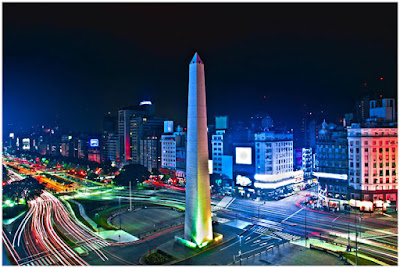
I'll be doing a seminar and two workshops in Buenos Aires in November. In the half-day seminar on the 17th, we'll move beyond F/stops and shutter speeds and take a step back to look at photography from a broader perspective. How can you approach your photography in a way that also incorporates your other skills and expertises? How can you turn this approach into sustainable business models and ecosystems?
Whether your goal is to make money or just to become more aware of and focused on who you are as a photographer, this talk is designed to prompt deeper thought. And because of the Contrastes Magazine's sponsorship, the talk is *free*. Well, at least for subscribers of the magazine. (Which means that if you are not yet a subscriber, the half-day seminar will only set you back the cost of a magazine subscription.)
On the 18th and 19th, I'll be teaching small-class workshops on lighting. These are shooting workshops, and are appropriate for anyone who wants to learn (or learn more) about small-flash lighting. Because of the sponsorshop, they are also economically priced.
More details are here: Buenos Aires Workshops
Dublin, December 3-5

I'll be both speaking and teaching for the Irish Professional Photographers Association in Dublin in December. More important: Italian photographer Sara Lando will also be teaching here during this time.
Sara and I will both be speaking on Sunday the 3rd. Sara will talk in the morning about the thousand things you wouldn't think about that go into a successful conceptual portrait session. I'll be talking in the afternoon about how to incorporate your photographic expertise into a wide range of external possibilities—and how to build digital and economic ecosystems around that.
On Monday and Tuesday the 4th and 5th, I'll be running a two-day, small-flash speedlight bootcamp. This is a small class, and we'll be shooting the whole time. But between us, where you really want to be is in either or both of Sara's two classes. Her unique approach to creative portraiture will cause you to completely re-examine your own approach. Honestly, the less creative you feel you are, the more you can benefit from spending a couple of days with her.
More details here, with early bird prices in effect until October 31: Dublin Workshops
X-Pedition Havana, January 12-19

Our inaugual Strobist X-Pedition is set for Havana, Cuba, from January 12-19. This is not a photo junket. This is an intensive week in perhaps the most photographically (and culturally, economically, etc.) interesting city in the western hemisphere.
The US government makes it a total pain in the butt to get to Cuba, and it is becoming far more so under the tightening restrictions. But having been there, I can tell you it is well worth the trouble. Go while you still can.
Our week is designed around learning and photography in a tight, small-group environment. When the light is crap, we'll be indoors learning how to think and see more like a photojournalist. When the light is right, we'll be out shooting. We have several location shoots lined up, and you'll get plenty of time to explore on your own as well. Throughout the week, we'll also be learning to bridge the perception-reality gap for lesser-traveled destinations.
Our goal by the end of the week is threefold: to make you a more observant and focused traveling photographer, to learn to shoot efficiently while retaining time for yourself and/or family while on the road, and to have the knowledge and experience to grab your camera and confidently head to nearly any place in the world.
This trip is nearly full. As of this writing, we have only one spot left in our Havana X-Pedition.
More details: X-Pedition Havana
__________
I'm stoked about each of these, and very much hope to see you there.
-DH
http://strobist.blogspot.com/2017/10/upcoming-strobist-events-buenos-aires.html
|
|
Lighting 103: Becoming More Intuitive with Color |
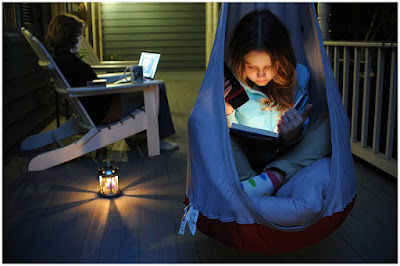
As your understanding of light and color grows, how does it affect your daily shooting? Like most things that seem complex at first, color pretty quickly becomes a secondary thought process, just like tying your shoes.
I just had the above archive photo picked up by a nonprofit, to promote children's books. Looking at it, I'm reminded that creating a natural looking color need not be complicated at all.
This was a little more than a snapshot, done with on-camera flash, and no gels. And the thought process behind the light is a good example of how you'll start to see and control color, even if you're just grabbing a snapshot. Read more »
http://strobist.blogspot.com/2017/09/becoming-intuitive-with-light-and-color.html
|
|
Lighting 103: How Designers Gel Live Performances |
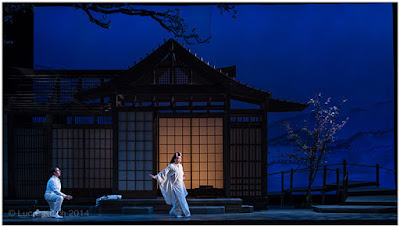
Photo © Lucas Krech
Today in Lighting 103, a little side trip. Fair warning: we are taking a bit of a deep dive. For some of you this will make your eyes glaze over. But for others, it'll be a very cool look into the way live performance lighting designers think with respect to color.
No worries; we'll be back in the center of the bell curve in the next installment.
A Chat with Lucas Krech
New York-based Lucas Krech is a lighting designer who works with operas, dances, plays and performance pieces. He is also is a photographer, which is how we originally intersected via Twitter.
A ways back, I wrote to him to find out a little more about how people approach the process of lighting live performances. What I got back was basically a firehose/brain dump that gave me a fascinating look into how he thinks. Read more »
http://strobist.blogspot.com/2017/09/how-designers-gel-live-performances.html
|
|
Major Updates to Strobist Lighting Kits |
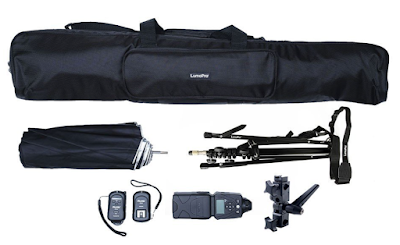
Strobist lighting kits are the modern day version of the basic speedlight-based setup I carried on my daily newspaper assigments for the better part of 20 years.
Over the past ten years, the recommended kit has gone through several evolutions. But recently there have been significant updates to several of the components (and a cool addition) making the kit better now than at any other time. I thought the updates merited a shoutout.
The kits are built around the idea of strong value with thoughtfully chosen components, many with unique features. All components carry best-in-class warranties, and can be expected to give you good service for years. If I was talking to myself as a 20-year-old, I'd advise me to get this before even buying a second lens.
The lighting kits come in several variations: Single with flash, single without flash, two-light version (two of everthing; but one remote) and add-a flash (one of everything, no remote).
Current components are as follows, with updates/additions noted:
Flash: LP180

The LumoPro LP180 is basically a bullet-proof (not literally, but relatively) manual flash that comes with the stuff you need, without the bells and whistles that you don't.
Notable features include four-way sync, 1/1 - 1/128 manual power, variable slave, selectable ready tone, smart thermal protection, power equal to or greater than OEM flagship flashes, 1/4"x20 side mount and built-in gel clips. (It also includes a gel kit that covers the most commonly used CC and theatrical colors.)
Build quality of the LP180 borders on ridiculous. (One was famously destroyed in the field by a leopard. It was replaced.)
Warranty: twice as long as OEM flagships.
Price: one-third of OEM flagships.
Remote: Phottix Ares Original Model

A legit remote trigger for not much more than the cost of a sync cord. Features include: AA-powered (no weird batteries to find) 8 channels, hot-shoe based mount and excellent reliability. Backed by a two-year warranty.
I have been teaching with (and using) these remotes for several years now. They are solid.
Stand: LP605S
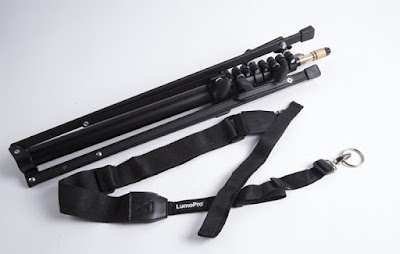
Recently updated; best in class. The LP605S is the classic, 5-section compact stand — except beefier build, and with a couple of unique added features.
One, it comes with folding ground spikes that will add to stability when used outside. Un-sandbagged umbrellas are always a risk in wind. But you can at least spike this stand and use bare flashes outdoors in a stiff breeze.
Two, the LP605S come predrilled for a strap, and includes the strap. This is somethng I DIY'd for many years, and the idea has now found its way to what was already the best compact stand on the market.
Umbrella: LumoPro 3-in-1 Double Fold

Recently swapped; best in class. Functionally similar to my older Westcotts, but with better build quality, more durability and added features.
The LP version gives you the choice of the best umbrella surface for any given job. It converts from white shoot-thru, to white reflective (black-backed) and silver reflective.
Unlike most double-folds, LP 3-in-1 umbrellas do not feel like fragile little flowers right out of the box. They are more substantial, and have lasted far longer than other models in daily use.
They also come with a slip case the does not make it feel like your umbrella is trying to squeeze into skinny jeans every time you try to case it.
Swivel: LP679-v2

Recently updated; best in class.
Finally, someone has nailed the swivel. The 679-v2 has all of the things common sense dictates in a swivel: removable cold shoe, big arm/smooth hinge, and a cold shoe post lockdown that does not bump up against your flash.
The recent improvement that sets it apart is in the umbrella lockdown screw. It is big and knurled. God only knows why, but most every other swivel I have seen puts a tiny thumb-mangler lockdown nub there. Why?
The LP679-v2 is LumoPro listening to photographers' upstream suggestions. As a result it is much better in practical use, comparatively speaking, than other swivels.
Bonus: Lighting in Layers
Lighting in Layers was a 6-DVD, 8-hour video tutorial series that sold for $159.99 from 2011 to 2016. (Full info here.) After six printings, the idea of physical DVDs had run its course. And since those DVDs had been very good to our family, I wanted to pay it forward to the next generation of lighting photographers.
So, all versions of the Jumpstarter kits purchased directly from Midwest Photo now include SD or thumbdrive versions of the Lighting in Layers video series. This is especially cool because one of the Jumpstarter kit versions (single/no flash) actually sells for less than the original cost of the DVDs.
VERY IMPORTANT, PLEASE NOTE:
Jumpstarter kits are available both on Amazon (finally!) and directly from Midwest Photo. Only the kits purchased directly from Midwest Photo include the video series. So if the video is important to you, choose Midwest. If not, you can go the easy two-click route through Amazon.
And A Case

All Jumpstarter kits (except Add a Light kit, which presumes you already have a case) include a padded shoulder case that big enough to hold a two-light kit and various odds and ends.
__________
A Caveat for Sony Users
If you are a Sony user, your camera may have a non-standard hot shoe. Sigh. Thanks Sony. Which means that this flash and remote (and, sadly, many other lighting components) may not fit your camera.
Fortunately, there are workarounds. Sony shooters are advised to email Midwest Photo and they will step you through any adapters you may need.
Different Versions / Where to Buy
The Jumpstarter kits are now also available via Amazon, which makes for a super-easy (two clicks) way to order. If you go that route, understand that the Amazon versions do not come with the lighting videos. That is a Midwest Photo in-store exclusive. Other that that, they are identical to the Midwest versions.
• If you already own a flash, single version without flash:
Midwest Photo (includes Lighting in Layers video): $147.99
Amazon, DOES NOT INCLUDE VIDEO: $147.99
• Single version, includes LP180 flash:
Midwest Photo (includes Lighting in Layers video): $276.99
Amazon, DOES NOT INCLUDE VIDEO: $276.99
• Two-light kit (portable, wireless 2-light studio, professional quality, for less than the cost of a single Nikon or Canon flagship flash):
Midwest Photo (includes Lighting in Layers video): $479.99
• Single add-a-light kit (includes flash but no remote or case):
Midwest Photo (includes Lighting in Layers video): $203.00
http://strobist.blogspot.com/2017/08/major-updates-to-strobist-lighting-kits.html
|
|
Major Updates to Strobist Lighting Kits |

Strobist lighting kits are the modern day version of the basic speedlight-based setup I carried on my daily newspaper assigments for the better part of 20 years.
Over the past ten years, the recommended kit has gone through several evolutions. But recently there have been significant updates to several of the components (and a cool addition) making the kit better now than at any other time. I thought the updates merited a shoutout.
The kits are built around the idea of strong value with thoughtfully chosen components, many with unique features. All components carry best-in-class warranties, and can be expected to give you good service for years. If I was talking to myself as a 20-year-old, I'd advise me to get this before even buying a second lens.
The lighting kits come in several variations: Single with flash, single without flash, two-light version (two of everthing; but one remote) and add-a flash (one of everything, no remote).
Current components are as follows, with updates/additions noted:
Flash: LP180

The LumoPro LP180 is basically a bullet-proof (not literally, but relatively) manual flash that comes with the stuff you need, without the bells and whistles that you don't.
Notable features include four-way sync, 1/1 - 1/128 manual power, variable slave, selectable ready tone, smart thermal protection, power equal to or greater than OEM flagship flashes, 1/4"x20 side mount and built-in gel clips. (It also includes a gel kit that covers the most commonly used CC and theatrical colors.)
Build quality of the LP180 borders on ridiculous. (One was famously destroyed in the field by a leopard. It was replaced.)
Warranty: twice as long as OEM flagships.
Price: one-third of OEM flagships.
Remote: Phottix Ares Original Model

A legit remote trigger for not much more than the cost of a sync cord. Features include: AA-powered (no weird batteries to find) 8 channels, hot-shoe based mount and excellent reliability. Backed by a two-year warranty.
I have been teaching with (and using) these remotes for several years now. They are solid.
Stand: LP605S

Recently updated; best in class. The LP605S is the classic, 5-section compact stand — except beefier build, and with a couple of unique added features.
One, it comes with folding ground spikes that will add to stability when used outside. Un-sandbagged umbrellas are always a risk in wind. But you can at least spike this stand and use bare flashes outdoors in a stiff breeze.
Two, the LP605S come predrilled for a strap, and includes the strap. This is somethng I DIY'd for many years, and the idea has now found its way to what was already the best compact stand on the market.
Umbrella: LumoPro 3-in-1 Double Fold

Recently swapped; best in class. Functionally similar to my older Westcotts, but with better build quality, more durability and added features.
The LP version gives you the choice of the best umbrella surface for any given job. It converts from white shoot-thru, to white reflective (black-backed) and silver reflective.
Unlike most double-folds, LP 3-in-1 umbrellas do not feel like fragile little flowers right out of the box. They are more substantial, and have lasted far longer than other models in daily use.
They also come with a slip case the does not make it feel like your umbrella is trying to squeeze into skinny jeans every time you try to case it.
Swivel: LP679-v2

Recently updated; best in class.
Finally, someone has nailed the swivel. The 679-v2 has all of the things common sense dictates in a swivel: removable cold shoe, big arm/smooth hinge, and a cold shoe post lockdown that does not bump up against your flash.
The recent improvement that sets it apart is in the umbrella lockdown screw. It is big and knurled. God only knows why, but most every other swivel I have seen puts a tiny thumb-mangler lockdown nub there. Why?
The LP679-v2 is LumoPro listening to photographers' upstream suggestions. As a result it is much better in practical use, comparatively speaking, than other swivels.
Bonus: Lighting in Layers
Lighting in Layers was a 6-DVD, 8-hour video tutorial series that sold for $159.99 from 2011 to 2016. (Full info here.) After six printings, the idea of physical DVDs had run its course. And since those DVDs had been very good to our family, I wanted to pay it forward to the next generation of lighting photographers.
So, all versions of the Jumpstarter kits purchased directly from Midwest Photo now include SD or thumbdrive versions of the Lighting in Layers video series. This is especially cool because one of the Jumpstarter kit versions (single/no flash) actually sells for less than the original cost of the DVDs.
VERY IMPORTANT, PLEASE NOTE:
Jumpstarter kits are available both on Amazon (finally!) and directly from Midwest Photo. Only the kits purchased directly from Midwest Photo include the video series. So if the video is important to you, choose Midwest. If not, you can go the easy two-click route through Amazon.
And A Case

All Jumpstarter kits (except Add a Light kit, which presumes you already have a case) include a padded shoulder case that big enough to hold a two-light kit and various odds and ends.
__________
A Caveat for Sony Users
If you are a Sony user, your camera may have a non-standard hot shoe. Sigh. Thanks Sony. Which means that this flash and remote (and, sadly, many other lighting components) may not fit your camera.
Fortunately, there are workarounds. Sony shooters are advised to email Midwest Photo and they will step you through any adapters you may need.
Different Versions / Where to Buy
The Jumpstarter kits are now also available via Amazon, which makes for a super-easy (two clicks) way to order. If you go that route, understand that the Amazon versions do not come with the lighting videos. That is a Midwest Photo in-store exclusive. Other that that, they are identical to the Midwest versions.
• If you already own a flash, single version without flash:
Midwest Photo (includes Lighting in Layers video): $147.99
Amazon, DOES NOT INCLUDE VIDEO: $147.99
• Single version, includes LP180 flash:
Midwest Photo (includes Lighting in Layers video): $276.99
Amazon, DOES NOT INCLUDE VIDEO: $276.99
• Two-light kit (portable, wireless 2-light studio, professional quality, for less than the cost of a single Nikon or Canon flagship flash):
Midwest Photo (includes Lighting in Layers video): $479.99
• Single add-a-light kit (includes flash but no remote or case):
Midwest Photo (includes Lighting in Layers video): $203.00
http://strobist.blogspot.com/2017/08/major-updates-to-strobist-lighting-kits.html
|
|
Lighting 103: Developing a Framework |
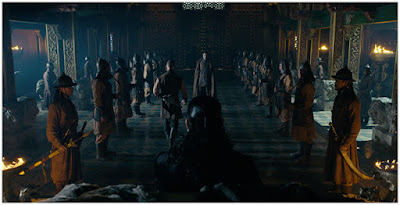
When you are placing a light source, it's pretty normal to ask yourself, "What color should this light be?"
If you step back a moment and think, the answer will often present itself. A better question to ask is, "What color would this light be?" Read more »
http://strobist.blogspot.com/2017/08/developing-framework.html
|
|
X-Pedition: Cuba |

Are you busy next January? I've been given the opportunity to lead a small-group photo trip to Havana, Cuba.
I was last in Havana in 2013, teaching for Santa Fe Workshops. But that was someone else's curriculum. This time the program is ours to design, and we are planning a week of exploring, learning and lots of time behind the camera.
If that sounds like your thing, keep reading.
An Immersive Week
This is not the typical photo tour group, which invariably ends up as some version of a photo walk with everyone getting versions of the same pictures. I'm working with Focus On The Story, a D.C.-based organization for photographers. The trip leaders are myself and fellow journalist Joe Newman, whom I've known for over 30 years.
Our trip will be more of a small-team experience, and very photo-centric. It will include instructional time as well as plenty of time to explore on your own—or with a teammate, if you prefer.

We'll always be out shooting at the edges of the day when the light is good, and at other times as dictated by the locations we have lined up. During the harsh light of midday, we'll typically be in instructional mode. We'll also be editing, comparing notes, evaluating what we can do better and preparing to go out and do it again.
Please note that this is not a lighting seminar. I am traveling very light—an X100F and a similar backup body just in case—and probably won't even bring a flash. We'll be more in photojournalist mode than studio mode.
In the evenings we'll continue the conversation, perhaps over a mojito or a glass of Cuba's famous dark rum. Nights in Havana are vibrant, with the sound of music filling the city. Its economic hardships may be well-known, but life and culture always find a way.
Finding Your Balance
We are traveling under a people-to-people license, which means you'll get lots of interaction with locals throughout the week. You'll also have time to absorb the city; to sit and watch the world go by. Whether along the Malec'on or on the Paseo Prado, Cuban life is always on display.
To always be in 100% photo mode is to miss one of the most important parts of the travel experience. Taking the time to observe the city both creates memories and informs your approach as a photographer when you pick the camera back up.
The X-Factor

The "X" in X-Pedition is a nod to Fuji's X series cameras. Small, light, quiet and unobtrusive, Fuji X series bodies are ideal travel cameras. I took a leap of faith on my first trip to Havana, bringing only a Fuji X100s with its fixed 35mm equivalent lens. In retrospect, it was a great decision. And it has changed the way I approach travel photography ever since.
So if you are also a Fuji shooter, you can expect tips and advice on how to get the most out of your cameras. Or to even borrow a lens if you like.
Do you have to be a Fuji shooter to come along? No, you don't. (And don't worry, we promise not to try to convert you.) But we do strongly suggest that you travel very light with respect to photo gear. It's good travel photo advice in general, but especially in a place like Cuba where the economic disparity is a factor.
The Bigger Picture
Havana is a unique opportunity for photographers. It goes without saying that it is not going to stay unique for very long. The island is already experiencing rapid change.
Our goal with this trip is to help you grow as both travelers and photographers; to gain the skills and confidence to choose future destinations that are off the beaten path.
__________
This trip will sell out. So if you are interested in joining us, don't sit on the fence too long. You can find full details and information on Focus On The Story's X-Pedition Cuba page.
Hope to see you there.
|
|
X-Pedition: Cuba |

Are you busy next January? I've been given the opportunity to lead a small-group photo trip to Havana, Cuba.
I was last in Havana in 2013, teaching for Santa Fe Workshops. But that was someone else's curriculum. This time the program is ours to design, and we are planning a week of exploring, learning and lots of time behind the camera.
If that sounds like your thing, keep reading.
An Immersive Week
This is not the typical photo tour group, which invariably ends up as some version of a photo walk with everyone getting versions of the same pictures. I'm working with Focus On The Story, a D.C.-based organization for photographers. The trip leaders are myself and fellow journalist Joe Newman, whom I've known for over 30 years.
Our trip will be more of a small-team experience, and very photo-centric. It will include instructional time as well as plenty of time to explore on your own—or with a teammate, if you prefer.

We'll always be out shooting at the edges of the day when the light is good, and at other times as dictated by the locations we have lined up. During the harsh light of midday, we'll typically be in instructional mode. We'll also be editing, comparing notes, evaluating what we can do better and preparing to go out and do it again.
Please note that this is not a lighting seminar. I am traveling very light—an X100F and a similar backup body just in case—and probably won't even bring a flash. We'll be more in photojournalist mode than studio mode.
In the evenings we'll continue the conversation, perhaps over a mojito or a glass of Cuba's famous dark rum. Nights in Havana are vibrant, with the sound of music filling the city. Its economic hardships may be well-known, but life and culture always find a way.
Finding Your Balance
We are traveling under a people-to-people license, which means you'll get lots of interaction with locals throughout the week. You'll also have time to absorb the city; to sit and watch the world go by. Whether along the Malec'on or on the Paseo Prado, Cuban life is always on display.
To always be in 100% photo mode is to miss one of the most important parts of the travel experience. Taking the time to observe the city both creates memories and informs your approach as a photographer when you pick the camera back up.
The X-Factor

The "X" in X-Pedition is a nod to Fuji's X series cameras. Small, light, quiet and unobtrusive, Fuji X series bodies are ideal travel cameras. I took a leap of faith on my first trip to Havana, bringing only a Fuji X100s with its fixed 35mm equivalent lens. In retrospect, it was a great decision. And it has changed the way I approach travel photography ever since.
So if you are also a Fuji shooter, you can expect tips and advice on how to get the most out of your cameras. Or to even borrow a lens if you like.
Do you have to be a Fuji shooter to come along? No, you don't. (And don't worry, we promise not to try to convert you.) But we do strongly suggest that you travel very light with respect to photo gear. It's good travel photo advice in general, but especially in a place like Cuba where the economic disparity is a factor.
The Bigger Picture
Havana is a unique opportunity for photographers. It goes without saying that it is not going to stay unique for very long. The island is already experiencing rapid change.
Our goal with this trip is to help you grow as both travelers and photographers; to gain the skills and confidence to choose future destinations that are off the beaten path.
__________
This trip will sell out. So if you are interested in joining us, don't sit on the fence too long. You can find full details and information on Focus On The Story's X-Pedition Cuba page.
Hope to see you there.
|
|
X-Pedition: Cuba |

Are you busy next January? I've been given the opportunity to lead a small-group photo trip to Havana, Cuba.
I was last in Havana in 2013, teaching for Santa Fe Workshops. But that was someone else's curriculum. This time the program is ours to design, and we are planning a week of exploring, learning and lots of time behind the camera.
If that sounds like your thing, keep reading.
An Immersive Week
This is not the typical photo tour group, which invariably ends up as some version of a photo walk with everyone getting versions of the same pictures. I'm working with Focus On The Story, a D.C.-based organization for photographers. The trip leaders are myself and fellow journalist Joe Newman, whom I've known for over 30 years.
Our trip will be more of a small-team experience, and very photo-centric. It will include instructional time as well as plenty of time to explore on your own—or with a teammate, if you prefer.

We'll always be out shooting at the edges of the day when the light is good, and at other times as dictated by the locations we have lined up. During the harsh light of midday, we'll typically be in instructional mode. We'll also be editing, comparing notes, evaluating what we can do better and preparing to go out and do it again.
Please note that this is not a lighting seminar. I am traveling very light—an X100F and a similar backup body just in case—and probably won't even bring a flash. We'll be more in photojournalist mode than studio mode.
In the evenings we'll continue the conversation, perhaps over a mojito or a glass of Cuba's famous dark rum. Nights in Havana are vibrant, with the sound of music filling the city. Its economic hardships may be well-known, but life and culture always find a way.
Finding Your Balance
We are traveling under a people-to-people license, which means you'll get lots of interaction with locals throughout the week. You'll also have time to absorb the city; to sit and watch the world go by. Whether along the Malec'on or on the Paseo Prado, Cuban life is always on display.
To always be in 100% photo mode is to miss one of the most important parts of the travel experience. Taking the time to observe the city both creates memories and informs your approach as a photographer when you pick the camera back up.
The X-Factor

The "X" in X-Pedition is a nod to Fuji's X series cameras. Small, light, quiet and unobtrusive, Fuji X series bodies are ideal travel cameras. I took a leap of faith on my first trip to Havana, bringing only a Fuji X100s with its fixed 35mm equivalent lens. In retrospect, it was a great decision. And it has changed the way I approach travel photography ever since.
So if you are also a Fuji shooter, you can expect tips and advice on how to get the most out of your cameras. Or to even borrow a lens if you like.
Do you have to be a Fuji shooter to come along? No, you don't. (And don't worry, we promise not to try to convert you.) But we do strongly suggest that you travel very light with respect to photo gear. It's good travel photo advice in general, but especially in a place like Cuba where the economic disparity is a factor.
The Bigger Picture
Havana is a unique opportunity for photographers. It goes without saying that it is not going to stay unique for very long. The island is already experiencing rapid change.
Our goal with this trip is to help you grow as both travelers and photographers; to gain the skills and confidence to choose future destinations that are off the beaten path.
__________
This trip
Hope to see you there.
|
|
Lighting 103: Learning From Your Couch |
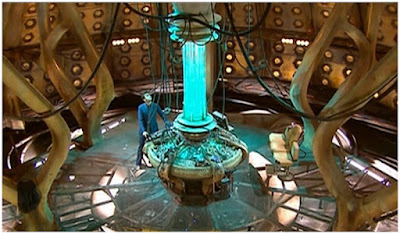
We may think we are getting a good feel for color as photographers. But you know who kicks still photographers' butts every day? Cinematographers, that's who.
Today, a look at some examples from 2010-era Dr. Who, which we have talked about on this blog before. These guys are near and dear to my heart, because they are unabashedly fearless when it comes to using color to manipulate light—and their viewers. Read more »
http://strobist.blogspot.com/2017/08/lighting-103-learning-from-your-couch.html
|
|
Lighting 103: Use Color to Evoke Time and Place |

This nighttime portrait of soprano Alexandra Rodrick was a big step for me. It was made about five years ago, when I was just starting to realize how color-fluid real light could be. I kinda knew it, but I still didn't have the nerve to actually do it.
So I took a deep breath and threw way more blue into the environment than I normally would. And not only did I come out alive on the other side, but I ended up pretty happy.
__________
I prevsiouly wrote in more detail about how we made the photo in On Assignment. It's a two-part post, if you're interested. So I won't fully rehash that here.
We wanted to evoke nighttime, but you can't really shoot this photo at night. Especially with the PhaseOne camera I shot this with. (You can see a full-sized version here.) The Phase effectively maxes out at ISO 100, and we wanted to get some depth and detail going way back into the scene. So we shot at twilight, and underexposed the ambient before adding three light sources into the mix.
Looking back, this photo was big leap forward for me. I took a chance and pushed a lot of CTB into the scene—full CTB, to be exact. We had to move the lights way back to light the scene evenly. In fact, here's my fill light coming from my second floor dining room, here:

Before this point, I would have weenied around with a 1/2 CTB, or even a 1/4 CTB.
The result would have been very much muted. Safer, maybe. But not nearly as evocative.
This is the first time I had really tried to connote the feeling of full night in a photo and actually had been willing to push some real color. Am I fully happy with it now? Not totally, and more on that in a minute.
But my advice is, while it is very tempting to try partial/interim color shifts, do yourself a favor and experiment with pushing some real color density into your frame. You may be pleasantly surprised at the result.
In the past I tried lesser color densities and ended up with pictures that were okay, but didn't really live up to what I pictured in my mind's eye. (Fortunately, no one else had access to my mind's eye, so my comparative failures were private affairs.)
What I am learning going forward is that the 1/4- and 1/2-measure color shifts come across as subtle in the final image. In fact, in many cases they would only be noticeable in their absence via side-by-side comparison.
And that subtlety is actually pretty cool and useful. Because as we have seen with portraiture, you can define what is in shadow with color as much as you can with density.
Think about it. By using a 1/2 CTB (maybe with a little green in there) in the shadows of a portrait against a 1/2 CTO key light in the highlights, you are defining shadows with color as much as you are with light levels.
This means you can not only get a more evocative palette of light on your subject, but you can vastly expand the range of visible detail in your photo. Because it is the color of light that is informing you in the shadow, rather than a harsher underexposure—and a corresponding lack of detail.
Our brain reads that relatively subtle blue shift also as signaling the transition to shadow. So if you are going to shift a whole scene to evoke a time and place—night in the woods, for instance—you'd better be willing to bring more color density to the party.
Don't be shy. Take a chance. You can always back off if you don't like it.
What I Would Do Differently Now
Back to Alexandra, I look at this frame and see that I was being relatively couragious (for me, then) in some parts of the photo, and a weenie in other parts.
Let's talk about the light on her face, courtesy a 1/4 CTO'd speedlight in a China ball.
Yes, it separates from all that blue night woodsy light. But why is it warm? I told myself at the time that it felt more theatrical (warm spotlight in cool environment and all). But really, it was also me long being comfortable throwing a warm light at my subject's face.
If I were shooting this today, I'd be more looking to integrate that key light into the scene. Less spotlight, more moonlight. As if she was catching a moon ray in the clearing.
I'd probably start with a 1/4 CTB. Cool her down, but but as much as the night woods. After all, moonlight is just reflected daylight.
And to that 1/4 CTB, I might consider adding a little green. Maybe 1/4 PlusGreen? Dunno, until I try it. But the idea would be to blend the moonlight with the influence of the green grass and leaves that would be filtering/reflecting it.
Would it be scary to try? Yeah, a little. I'm not used to blue-green faces in my photos. Not even a little bit. But it wouldn't be nearly as scary now as it would have been for me back in 2012.
And to be honest, 2017 me thinks the slight blue-green face would look better. Which is the point of taking chances with your light, finding new things that work and the result being growth as a photographer.
This is the most recent post in Strobist's Lighting 103 module. New installments publish on the first and third Thursday of each month. If you would like to be notified as they become available, please sign up here.
http://strobist.blogspot.com/2017/07/use-color-to-evoke-time-and-place.html
|
|
Lighting 103: Use Color to Evoke Time and Place |

This nighttime portrait of soprano Alexandra Rodrick was a big step for me. It was made about five years ago, when I was just starting to realize how color-fluid real light could be. I kinda knew it, but I still didn't have the nerve to actually do it.
So I took a deep breath and threw way more blue into the environment than I normally would. And not only did I come out alive on the other side, but I ended up pretty happy. Read more »
http://strobist.blogspot.com/2017/07/use-color-to-evoke-time-and-place.html
|
|
Lighting 103: Avoiding Cross Contamination |
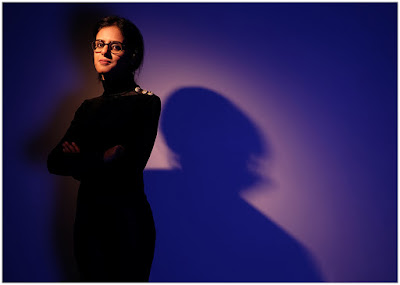
Above is a two-speedlight portrait against a white wall. White walls are the natural enemy of a gel, and practically live to wash out your color. Especially when using two flashes with dense, complementary gels. Knowing how to keep your multi-colored lights operating on different planes will help you retain more saturated color.
Let's walk through the portrait above to get a better look at how our two lights are working separately—and together—in a variety of ways.Read more »
http://strobist.blogspot.com/2017/07/avoiding-cross-contamination.html
|
|
Lighting 103: Greg's Assignment: Results |
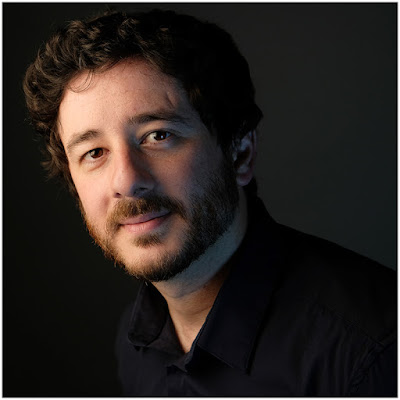
Reporting in from our last assignment, in which you were asked to shoot a portrait in three different ways: clean white light, warm/cool light, and warm/cool light with the shadows muddied up with a little green. I did this one along with you—twice—and learned a lot in the process.
Which brings up a valuable point. You can read about this stuff all you want. But until you actually get off your ass and do it, you're not going to learn it.
In other words, learning to use color in your lighting is just like anything else. Read more »
http://strobist.blogspot.com/2017/06/gregs-assignment-results.html
|
|
Lighting 103: Greg's Assignment: Results |

Reporting in from our last assignment, in which you were asked to shoot a portrait in three different ways: clean white light, warm/cool light, and warm/cool light with the shadows muddied up with a little green. I did this one along with you—twice—and learned a lot in the process.
Which brings up a valuable point. You can read about this stuff all you want. But until you actually get off your ass and do it, you're not going to learn it.
In other words, learning to use color in your lighting is just like anything else. Read more »
http://strobist.blogspot.com/2017/06/gregs-assignment-results.html
|
|
Lighting 103: Greg's Assignment |
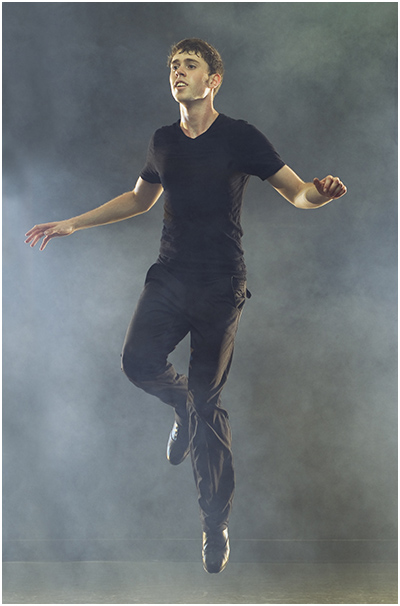
In the last part of our conversation with Greg Heisler, he gave what I think is a very good piece of advice about light and color:
"I think what you have to do to be able to see it, is to shoot it. And then shoot it.
Like, shoot it the clean way, with white light. Then the next way is to shoot it with a warm and a cool. And so you see that. And then muddy up the light a little bit, and then see it that way."
So that's exactly what we're gonna do. Read more »
|
|
Jinbei Studio Flash Units Recalled for Electrocution Risk |
http://strobist.blogspot.com/2017/05/jinbei-studio-flash-units-recalled-for.html
|
|
Lighting 103: Greg Heisler on Light and Color |
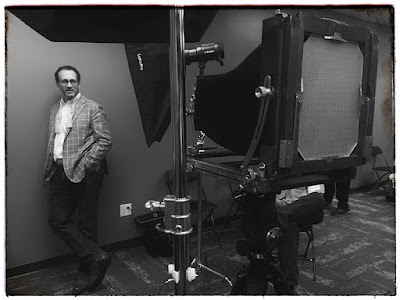
Today’s Lighting 103 post features excerpts from a bar conversation with Greg Heisler. It's just as if we cornered him at a conference (which I did) and he agreed to have a drink and talk color (which he did).
This is roadmap stuff. It's above and beyond the specific info he includes with each of the assignments in his book, 50 Portraits, the companion text to L103.Read more »
http://strobist.blogspot.com/2017/05/greg-heisler-on-light-and-color.html
|
|
Lighting 103: Use Gels to Tune Your Home's Lighting |

So far, everything we have done has centered on gelling a single light to create a single desired color shift. But before we make the jump into using multiple colors and light sources, one quick hack for your home's lighting that will help you to improve the quality of light in compact fluorescent and LED bulbs.
Like the gawdawful green-tinged lamp above, for example. Read more »
http://strobist.blogspot.com/2017/05/use-gels-to-tune-your-homes-lighting.html
|
|
Lighting 103: Using Gels to Shift the Ambient |
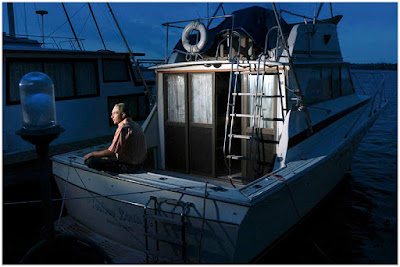
In addition to controlling the color of light from your flash, gels can also allow you to alter the color of the ambient areas of your frame. The portrait above, done for the Baltimore Sun, is a good example. I made it as a storm approached, and the light was gray and pretty neutral.
The light was okay, but not great. I really wanted was a stronger color environment for the photo. And I also wanted the subject to pop more. So instead of daylight white balance, I shot it on incandescent (tungsten) white balance. This shifted the expected light source from 5600k to 3200k. In essence, the camera was expecting to shoot under tungsten lights. Read more »
http://strobist.blogspot.com/2017/04/using-gels-to-shift-ambient.html
|
|







